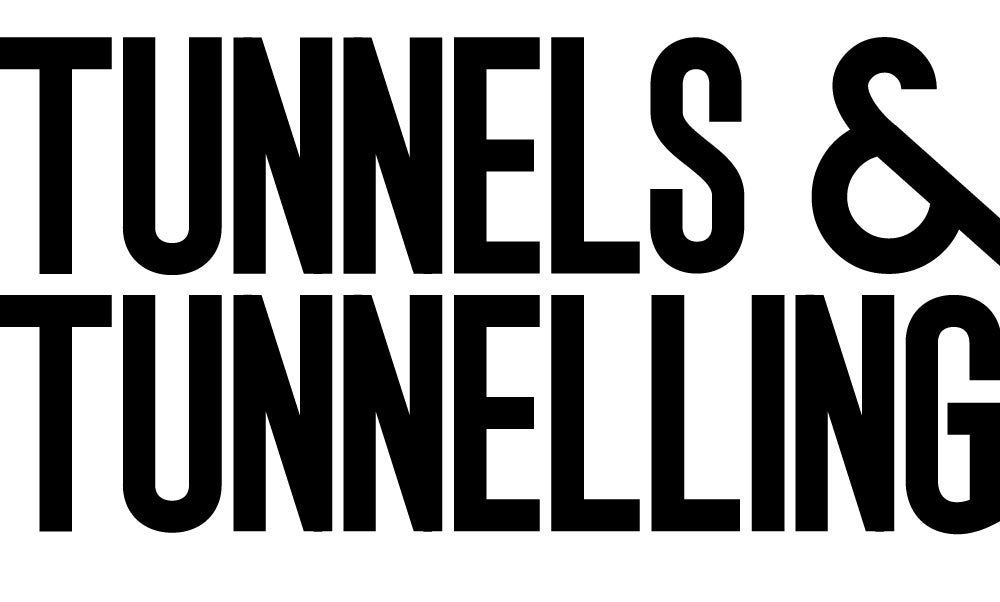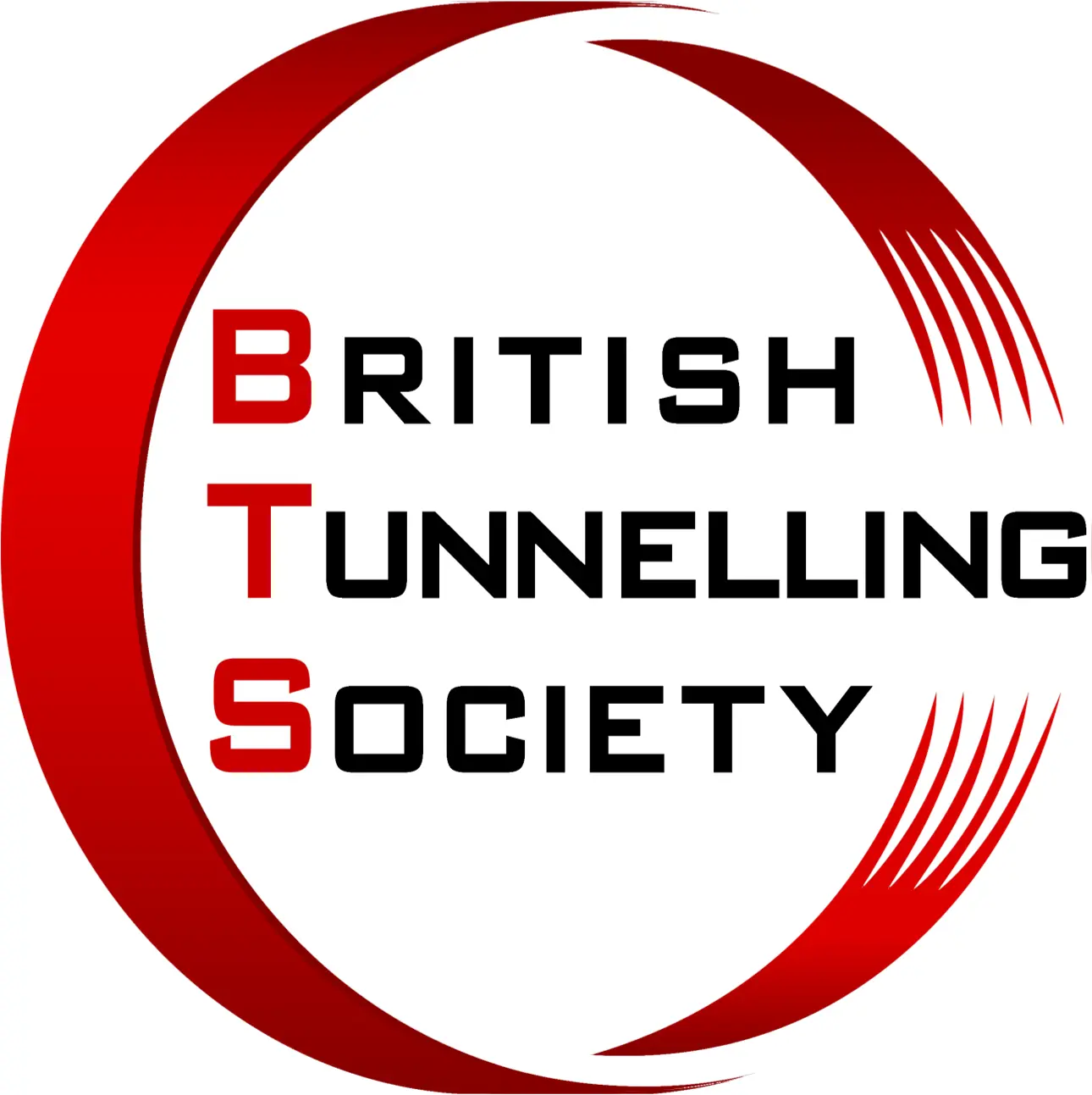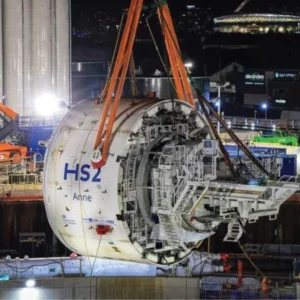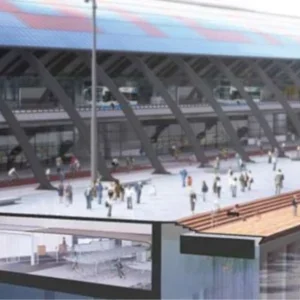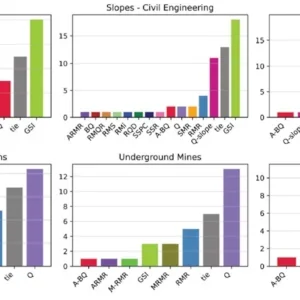The project is located in the Muzaffarabad District of Azad Jammu & Kashmir (AJK), in north-eastern Pakistan within the Himalayan foothill zone known as the Sub-Himalayan Range. The terrain is rugged with elevations that range from 600 to 3,200m above sea level. The project is a run-of-river scheme, employing 28.6km of headrace and 3.6km of tailrace tunnels that bypass a major loop in the river system, transferring waters from the Neelum River into the Jhelum River, for a total static head gain of 420m (Figure 1). The headrace tunnels include both single bore (31 per cent) and twin bores (69 per cent). The tailrace tunnel consists of a single tunnel. Design capacity of the waterway system is 283m3/s. The project will have an installed capacity of 969MW, generated by four Francis turbines located in an underground powerhouse.
Tunneling commenced in 2008 using conventional drill & blast techniques. It soon became apparent that a 13.5km-long section of the twin headrace tunnels (under high hilly overburden that precluded construction of additional access adits) would take too long to excavate by drill and blast. The contract was amended to incorporate two Herrenknecht 8.5m-diameter main beam gripper hard rock TBMs to excavate approximately 10.5km of twin headrace tunnels (Figure 1). The gripper design offered flexibility for the expected conditions: possible squeezing ground given the relatively weak rock mass and overburdens up to 1870 meters, and the potential for rockbursts in the stronger beds.
GEOLOGICAL SETTING
The entire project was excavated in the sedimentary rocks of the Murree Formation, which is of Eocene to Miocene age. The TBM tunnels were constructed through a zone bounded by two major Himalayan faults that trend sub-perpendicular to the tunnels: the Main Boundary Thrust, and the subsidiary Muzaffarabad reverse/thrust fault (see Figure 1). The Uniaxial Compressive Strengths (UCS) of the various lithologies are as follows:
- Siltstones & Silty Sandstones: UCS in the 50 to 70MPa range.
- Mudstones: UCSs in the 30 to 40MPa range.
- Sandstones: UCSs in the 130 to 230MPa range.
In-situ stress measurements by overcoring in sandstone beds in the TBM tunnels indicated a ‘tectonic zone’ of high stresses (k up to 2.9) where the major principal stress is oriented subhorizontally, and nearly normal to the tunnel azimuth.
TBM configuration and tunnel chainages
This technical paper will use the tunnel chainages allocated to the TBM excavated section of the project. The two twin tunnels were excavated between chainages of 15+600 and 5+200. Excavation commenced at Lot C2 (shown in Figure 1) towards the north-east, starting at the higher number and proceeding towards the lower number.
Open gripper TBMs are designed fundamentally for hard, competent rock where little to no support is required. The disc cutters are pressed against the rock as the cutterhead rotates. The required thrust of the cutterhead is provided by grippers braced against the tunnel wall. After one stroke is completed, the rear cutterhead support is lowered and the grippers and cylinders are pulled in. They are then repositioned for the next boring cycle. The grippers then engage the tunnel wall, the rear cutterhead support is raised and the next cycle starts. Initial support is applied at the ‘L1 zone’ just behind the TBM shield and permanent support at the ‘L2 zone’.
Summary of rockburst activity
No rockbursts were encountered in the initial 2.3km of either TBM tunnel. After this point rockbursts in both tunnels commenced and gradually increased in number and magnitude. However, it was only from November 2014, with 4.7km (45 per cent) of the left tunnel and 4.3km of the right tunnel completed that rockbursts were occurring on a regular enough basis to merit systematic recording. This increase in rockburst activity coincided with increasing overburdens and corresponding higher stresses in the rock mass. While the elevated horizontal stresses undoubtedly played a major role in the severity of the rockbursts, the zone of high frequency rockbursts also appeared to correspond to a deeply eroded valley beneath which the TBM was excavating. The frequency of rockbursts declined dramatically when surface topography switched from a creek valley to a ridgeline.
A system was devised whereby every rockburst event would be categorised by magnitude, ranging from noise only to major rockburst. The system’s principal aim was to facilitate the decision-making process for the application of mitigation measures at the TBM by gaining an understanding of the timing and distribution of rockbursts. These are however outside of the scope of this paper.
The cumulative rockbursts for the leading and trailing TBMs are shown in Figure 2. The TBMs are identified by their company model numbers: 696 and 697, and excavated the right and left tunnels respectively. For the vast majority of the twin tunnel excavation the leading TBM was 697 and the trailing TBM was 696.
Figure 2 shows that 990 rockbursts recorded over the complete excavation period. The severe 31 May event, often also referred to as the ‘5/31 event’, is highlighted in the bottom left hand corner. At the time of the 31 May event the two TBMs were separated by 120m following the same alignment. The 31 May event delayed the TBM 696 (trailing) by 7.5 months and created a separation of 1,600m, which was maintained until completion of the tunnels. The centre-to-centre distance between the TBM tunnels was increased in order to reduce the stresses acting in the pillar. This distance was initially 33.0 m and was eventually increased to 55.5m, as shown in Figure 2.
General geological conditions
From the start of excavation and up to chainage 09+790, the geology encountered by both TBMs was similar with perpendicular bedding of alternating sandstone and siltstone beds.
Figure 3 illustrates the very similar geology encountered in the twin TBM tunnels prior to the 31 May event. All rock units have a strike in the northwest direction and dip northeast. The angle of dip ranges from 55° to 65°.
Geological Conditions immediately before the 31 May event
When TBM 697 crossed chainage 09+790, no bedding joints were found in next 40m of the tunnel. This section was later interpreted as the core of an anticline.
After crossing the core of this anticline, abnormal bedding joints parallel to the tunnel alignment with a gentle dip were encountered (Figure 5).
This 50m section of gentle dip was interpreted as the common limb of an anticline and syncline. Gentle and parallel bedding joints disappeared again in the next 40m section which was subsequently interpreted as the core of a syncline. Steep bedding joints with normal orientation were found again from chainage 09+656. The advance rate of TBM 697 was relatively good in this abnormal bedding arrangement, with 134m excavated in 10 days between chainages 09+790 to 09+656. Only two minor rockbursts were recorded in this section of massive siltstone.
THE 31 MAY EVENT Effect on TBM 696 (trailing)
The 31 May event occurred on TBM 696 (in the right tunnel) at approximately 11.35 pm on 31 May 2015. The magnitude of the event and consequent damages to the TBM, ancillary equipment and rock support were without precedent on the project. Figure 6 shows the same location after the 31 May event.
The physical damage and losses were sudden and unforeseen. The rockburst occurred when TBM 696 was in midstroke with the cutterhead at a chainage of 9+706. Visible damage was observed along the tunnel between chainages 9+712 and 9+785, with the most severe damage to the TBM, excavation profile and permanent rock support in a 22m section between chainages 9+740 and 9+762 (28 to 50m behind the shield). The maximum impact of the 31 May event was felt at a chainage of 9+751. The TBM cutterhead passed through this point 10 days before the 31 May event.
The time lag between excavation and occurrence of the rockburst was unusual. Between chainages 9+740 and 9+762, damage to the rock support and excavation profile was concentrated in two quadrants of the tunnel perimeter looking in the direction of excavation, the lower right quadrant (3 o’clock to 6 o’clock) and the upper left quadrant (9 o’clock to 12 o’clock ). The most severe damage occurred in the lower right quadrant with 2.0 – 2.5m of ‘overbreak (RB)’ observed in places, (here overbreak [RB] is used to indicate excavation profile change due to rockburst, as opposed to the conventional usage). The TBM was completely blocked by ejected material in two locations (Figure 7). Invert heave was evident throughout the 22m long most affected zone, with many of the steel ring beams sheared, displaced into the tunnel and lifted above the invert, along with the track and sleepers. In some areas the ring beams were also heaved out of position, causing secondary damage to the adjacent shotcrete.
L2 permanent support in the form of shotcrete had been installed up to a chainage of 9+775. Damage to the L2 permanent shotcrete was observed back to a chainage of about 9+792. In the upper left quadrant large blocks of L2 shotcrete delaminated from the initial L1 shotcrete layer. L1 shotcrete had been completed up to a chainage of 9+712, with wire mesh and ring beam installation complete to a chainage of 9+713, and expansion shell bolt installation complete to a chainage of 9+715. All of the mentioned support elements were severely damaged. Figure 7 shows the complete shearing of the most robust support element used, the full steel ring beam.
Effect on TBM 697 (leading)
When the 31 May event occurred, the leading TBM 697 was 180m ahead of the trailing TBM 696 and the pillar separating the tunnels was 25m wide. However the TBM still suffered the effects of the 31 May event. The consequences of this event could be witnessed between chainages 9+706 and 9+790 on both sides of the TBM 697 tunnel.
Unusual characteristics of the event
The 31 May event had the following unusual characteristics: 1. The scale and extent of the damage to the TBM was unprecedented.
2. The stress trajectory interpreted from the overbreak (RB) pattern ran perpendicular to the direction typically observed. 3. Previous rockbursts encountered typically occurred above the shield (within 5m of the face) or close behind it at the L1 zone. The 31 May event had its epicentre at the L2 zone, 60 – 68m behind the face, and propagated towards the front of the TBM.
4. Before this event, overbreak (RB) due to rockbursts had typically only occurred in the upper quadrants. This time it also occurred in the lower right side quadrant.
5. It damaged the rock support on the TBM 697 (leading TBM) tunnel wall. It was extremely unusual for a rockburst in one tunnel to affect the adjacent tunnel.
6. Typically, the bedding planes strike in a direction subperpendicular to the tunnel alignment. At the location of the 31 May event, they are oriented sub-parallel to the tunnel. 7. Before the event, the higher intensity rockbursts typically occurred in the tunnel excavated by the leading TBM as opposed to the trailing TBM.
8. Probing ahead of the TBM encountered only siltstone. Before the 31 May event, siltstone had not been found to be prone to rockburst.
9. The leading TBM 697 passed through the location of the 31 May event without incident.
10. The event occurred nearly 10 days after TBM 696 cutterhead cut through the ’epicentre’ of the rockburst. Typically on both TBMs the rockbursts occurred during the same working shift of excavation of the epicentre.
RESPONSE TO THE 31 MAY EVENT
After the emergency evacuation of all tunnel personnel, the TBM became an exclusion zone until the situation could be full appraised. The TBM rockbursts could be heard continuing for eight days after the 31 May event 200m behind the TBM. A series of inspections were undertaken in order to assess safe access and develop a work plan to start the recovery of both the TBM and the tunnel support. It was also important to determine the TBM components damaged, since some replacement parts would take up to six months to arrive on site. The extent of the damage was widespread over the first 80m of the 190m long TBM. The worst-affected location was a 22m long zone 40m behind the cutterhead, where the tunnel had seemingly imploded bringing debris down from 9m above the originally excavated profile, 3m from the side and 2.5m from the invert. This completely blocked the TBM at the location of the main cutterhead power pack and the L2 shotcrete installation zone. The severely damaged zone had also caused the bridge section (weighing 200 tonnes), to be thrust 800mm anticlockwise (looking upstream) and become severely twisted within the excavated tunnel. Although this section had its orientation shifted, the towing brackets which connect the various TBM components (gantries) remained intact.
TBM recovery works – debris emoval and support installation
Once the area was deemed safe to enter and the recovery plan had been developed, recovery work commenced on 16 June 2015. The most urgent activity was to start the debris removal from the top of the TBM to allow the replacement of tunnel rock support and also uncover the full extent of the rockburst zone. The recovery operations started from a position of safety 80m behind the TBM shield and progressively moved forwards towards the worst-affected zone. The initial debris removal started from the upper deck of the TBM with material removed by hand. The conveyor belt running along the length of the TBM was removed periodically to allow the rock debris to be loaded into railway mounted skips at the invert. This difficult and time consuming work was greatly improved by the arrival of four mini excavators. One of these excavators is shown in Figure 8. It soon became apparent that the rockburst zone was more extensive than initially envisaged. It meant that a special temporary access platform, shown in Figure 9 (top), had to be installed on top of the TBM back up gantries to allow access for debris removal and rock support installation. This zone was continued for 60m of the 80m rockburst zone. Removal of debris and installation of new rock support continued until the end of August 2015. Once the crown and side walls had been recovered and rock support installed, the recovery of the tunnel invert could be commenced. This operation was the reverse of the upper zone recovery as the sequence started at the front of the TBM and progressed downstream towards the rear of the TBM. Again the full extent of the damage was revealed as the invert was recovered and exposed in the most extreme case a loosened or crushed area 2.5m outside of the envelope of the already excavated TBM tunnel, shown in figure 9 (bottom).
The invert section debris was removed and re-supported by the end of September 2017 and the rails for the tunnel locomotive installed on raised concrete blocks. Figure 9 (a) shows the full extent of the rockburst zone around the tunnel and also gives an indication of the ground stress release profile which resulted in the 31 May event.
Once the invert of the tunnel had been recovered, the operation to realign the bridge section back to its correct position could be undertaken. This involved installing eight sets of steel supports each equipped with 100 tonne capacity hydraulic jacks.
The eight sets of support were installed and the hydraulic jacks extended to support the bridge section as shown in Figure 10 (top). Once supported, this allowed the invert debris to be removed from underneath the multiple wheels below the bridge section, as shown in Figure 10 (bottom). The hydraulic jacks were then slowly adjusted one by one until the bridge section was returned to its correct alignment and the 800mm twist had been corrected. One of the four sets of multiple wheels supporting the bridge section had been badly buckled and was replaced. The tunnel rail track was then reinstalled and the whole bridge section was lowered down in one operation and positioned on the new rail track.
Concern for the cutterhead and main bearing
As the TBM was actually excavating when the 31 May event took place, the cutterhead stopped instantaneously and the TBM roof support portion of the shield was forced down. This crushed the roof support cylinders and the left hand side, squeezing the side support portion of the TBM shield inwards.
The cutterhead main bearing had electrical protection on the 12 drive motors, by way of safe sets which disengage the drive motor from the main bearing to prevent damage to the main bearing and cutterhead. The normal operation is that, one safe set will activate and the power will be isolated to all the remaining drive motors. The 31 May event was so ferocious that not one but six safe sets were disengaged. This was extremely unusual and signaled the probability of significant damage to the cutterhead, cutterhead mountings and main bearing. The only way to investigate if significant damage or deformation had occurred was to free the equipment and then carry out functional tests on each item.
The cutterhead and front shield of the TBM fit tightly within the tunnel, and in order to inspect and test it, all of the ejected material on the cutterhead had to be removed. The only practical way to do this was to excavate a pilot tunnel around the TBM shield by manual methods, the size being kept to a minimum to allow safe man access and working space. The upper 270° around the TBM had to be uncovered to allow inspection of the cutterhead, main bearing, roof supports and side supports. The pilot tunnel was excavated between October 2015 and December 2015. A thorough examination was then undertaken of the main bearing housing and circumferential gaps between the cutterhead. This revealed that the cutterhead had been deflected some 13mm by the 31 May event, although it was still deemed acceptable to recommence tunnel excavation.
Support design for area damaged by the 31 May Event
Figure 11 shows the initial support installed at the L1 zone and the profile of the rock after the 31 May event at the epicenter. The design of the rock support was undertaken holistically with the design of the permanent lining. As a circular formwork was already available, this was to be used to place a 350mm thick concrete lining. The rock exposed by the 31 May event was supported by shotcrete, wire mesh and rock bolts (Figure 12a). There were four stages to the installation of the permanent support (Figure 12b):
1. The overbreak areas in the invert was backfilled with a low strength concrete
2. The circular concrete lining was placed using the formwork (with concreting pipes left in the crown)
3. The overbreak above the crown was filled with pumped Concrete
4. Contact and consolidation grouting was carried out 5. Drainage holes were drilled through the lining
TBM equipment repair and replacement
After the removal of all of the debris and installation of new rock support, the damaged TBM components could be replaced. This included all three major power packs for the L1 zone, L2 zone and cutterhead drive unit. The L2 zone was at the epicenter of the 31 May event. Numerous electrical cables, the bridge section, bridge section wheels, the control cabin, main material crane and the cutterhead safe sets for isolating the cutterhead motors were damaged and had to be repaired or replaced. All of this work was completed by the 9 January 2016.
Recommencement of excavation
The recovery of the TBM tunnel and the installation of the replacement TBM components damaged by the 31 May event took just under seven and a half months after the 31 May event. Excavation recommenced on 10 January 2016.
Rockburst mitigation measures During the recovery period for TBM 696, the leading TBM 697 continued excavation and was 1.5km ahead of TBM 696 by 10 January 2016. In this period a series of rockburst mitigation measures had been devised, developed, implemented and refined. All these mitigation measures would also be used on TBM 696. These allowed zones with high potential for rockbursts to be identified in advance. A special rock support design was implemented in these zones, which included more shotcrete applied at the L1 zone, extra bolting, the drilling of longitudinal and radial stress relief holes, etc. From Figure 5 the revised geological mapping indicated a fold structure in front of the TBM which was expected be highly stressed and TBM 696 experienced over 60 rockbursts between recommencing on 10 January and up to 5 March 2017 when a total of 94m had been excavated. This initial period of excavation was the most challenging with rockbursts starting immediately after cutterhead rotation resumed. However, TBM operations continued through difficult conditions and after 6 March the tunnel alignment progressed back into the previously typical sequence of alternating sandstone and siltstone beds. TBM 696 continued and in May 2017 broke through, connecting with the dam site having completed 9.9km of excavation through very challenging geology and in extremely difficult conditions.
CONCLUSIONS
This paper outlines the unusual circumstances under which the 31 May rockburst event occurred. The geological conditions are described and then the actual physical effects of this extraordinary event.
The damage caused is described extensively and the impressive response to the event; both for the recovery of the TBM and the recommencement of excavation is detailed. These tasks were made much more difficult by the remote location of the project site, making both recovery of the machine and delivery of the required spare parts all the more taxing. This coupled with the unusual severity of the 31 May event made the recovery all the more impressive. The event and the subsequent detailed investigation resulted in new TBM operational procedures aimed at predicting and investigating future similar geological situations.
The most important of these measures was the adoption of probing through the side wall of the tunnel to detect parallel, hidden sandstone beds. The successful recommencement of tunneling and subsequent tunnel completion was only made possible by the full support of the client and close collaborative working between the employer, contractor and engineer.
